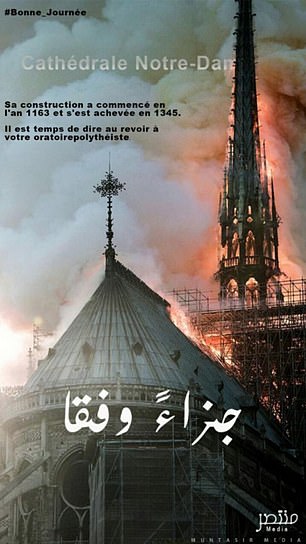
Islamic State fanatics are heartlessly revelling in the inferno at Notre Dame Cathedral online calling it ‘retribution and punishment’, according to terror intelligence researchers.
A poster of the blazing cathedral is accompanied by the words, ‘Have a good day,’ and was created by the ISIS affiliated Al-Muntasir group according to the Terrorism Research & Analysis Consortium.
The poster says: ‘Its construction began in the year 1163 and ended in 1345. It’s time to say goodbye to your oratory polytheism.’
The chilling message appeared as firefighters continued their efforts to put out the blaze late on Monday night.
The Al-Munatsir media organisation has shared propaganda rejoicing in terror attacks which have rocked France in recent years.
The Paris prosecutor’s office said it was treating the fire as an accident, ruling out arson and possible terror-related motives, at least for now.
While the jihadists celebrated online, France and the world mourned the destruction of a glorious symbol of Western civilisation.
French President Emmanuel Macron treated the fire as a national emergency, rushing to the scene and cancelling a previously scheduled televised address meant to address France’s yellow vest crisis.
‘The worse has been avoided, although the battle is not yet totally won,’ the president said, adding that he would launch a national funding campaign on Tuesday and call on the world’s ‘greatest talents’ to help rebuild the monument.
‘Notre Dame of Paris is our history, our literature, our imagination. The place where we survived epidemics, wars, liberation. It has been the epicenter of our lives,’ Macron said from the scene.
Notre Dame was ravaged as the fire swept across the top of the building around a renovation project before its spire collapsed, threatening priceless architecture and artworks throughout the cathedral.
The 12th-century church is home to relics, stained glass and other incalculable works of art and is a leading tourist attraction.
French media quoted the Paris fire brigade as saying the fire was ‘potentially linked’ to a 6 million euro (£5.2 million) renovation project on the spire and its 500 tons of wood and 250 tons of lead.
Despite the dramatic image of the flaming cathedral, no one was killed.
One firefighter was injured, among some 400 who battled the flames for hours before finally extinguishing them.
Firefighters continued working through the night to cool the building and secure the monument and announced on Tuesday morning the fire had been extinguished.
The blaze started at 6.50pm after the cathedral had closed to the public, and spread to one of its landmark rectangular towers.
Nearby buildings were evacuated as fears mounted that the structure could collapse.
As the spire fell, the sky lit orange, acrid smoke rose in plumes and flames shot out the roof behind the nave.
Hundreds of people lined bridges around the island that houses the church, one of the most visited tourist attractions in the world.
Paris fire chief Jean-Claude Gallet said the structure had been saved after firefighters managed to stop the fire spreading to the northern belfry. Gallet said ‘two-thirds of the roofing has been ravaged.’
The fire came less than a week before Easter amid Holy Week commemorations.
As the cathedral burned, Parisians gathered spontaneously to pray and sing hymns outside the church of Saint-Julien-Les-Pauvres across the river from Notre Dame while the flames lit the sky behind them.
Paris Archbishop Michel Aupetit invited priests across France to ring church bells in a call for prayers.
Experts say firefighters were left with devastatingly few options to save a structure that’s more than 850 years old, built with heavy timber construction and soaring open spaces, and lacking sophisticated fire-protection systems.
Built in the 12th and 13th centuries, Notre Dame is the most famous of the Gothic cathedrals of the Middle Ages.
Situated on the Ile de la Cite, an island in the Seine river, its architecture is famous for, among other things, its many gargoyles and its iconic flying buttresses. Some 13 million people visit it every year.


